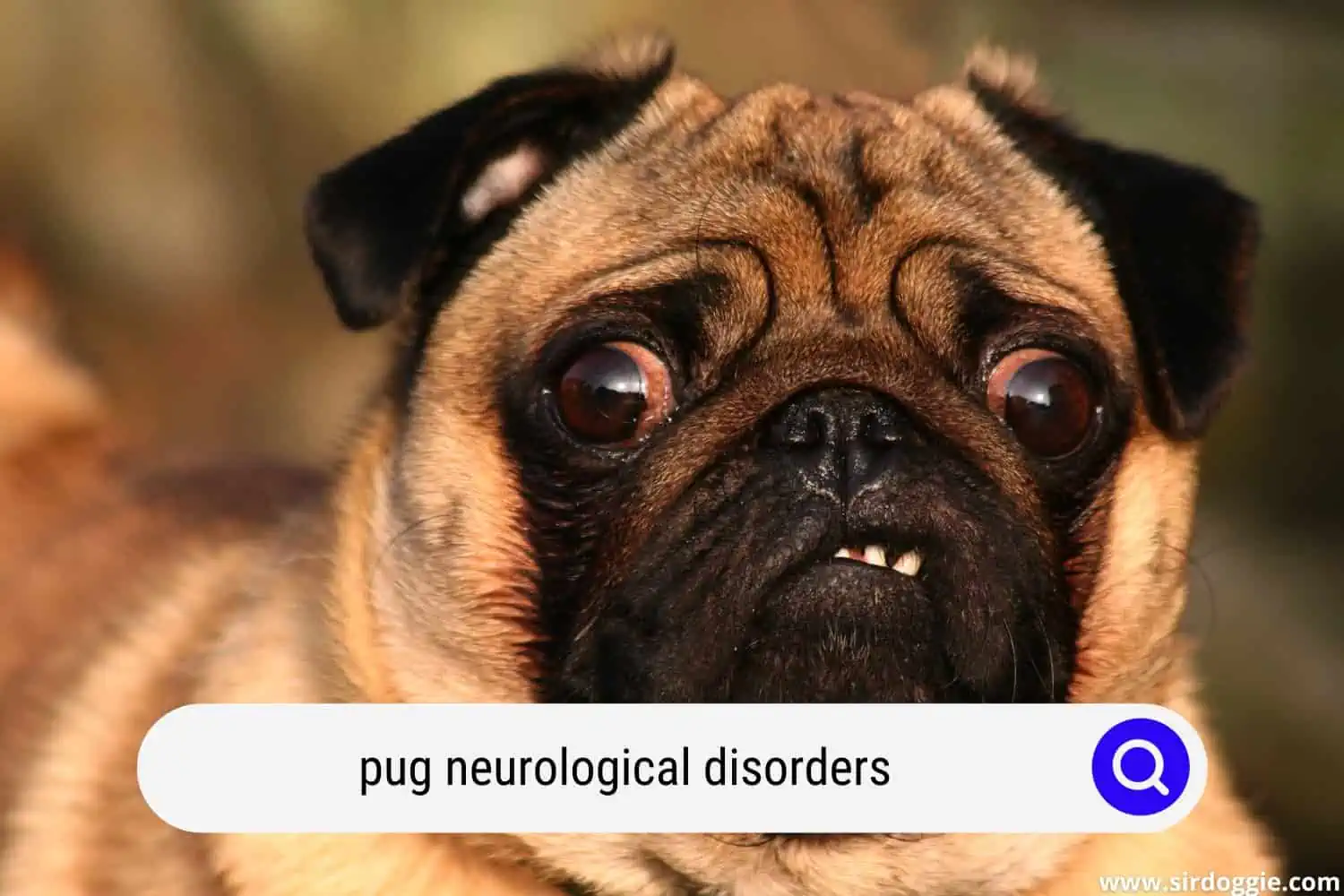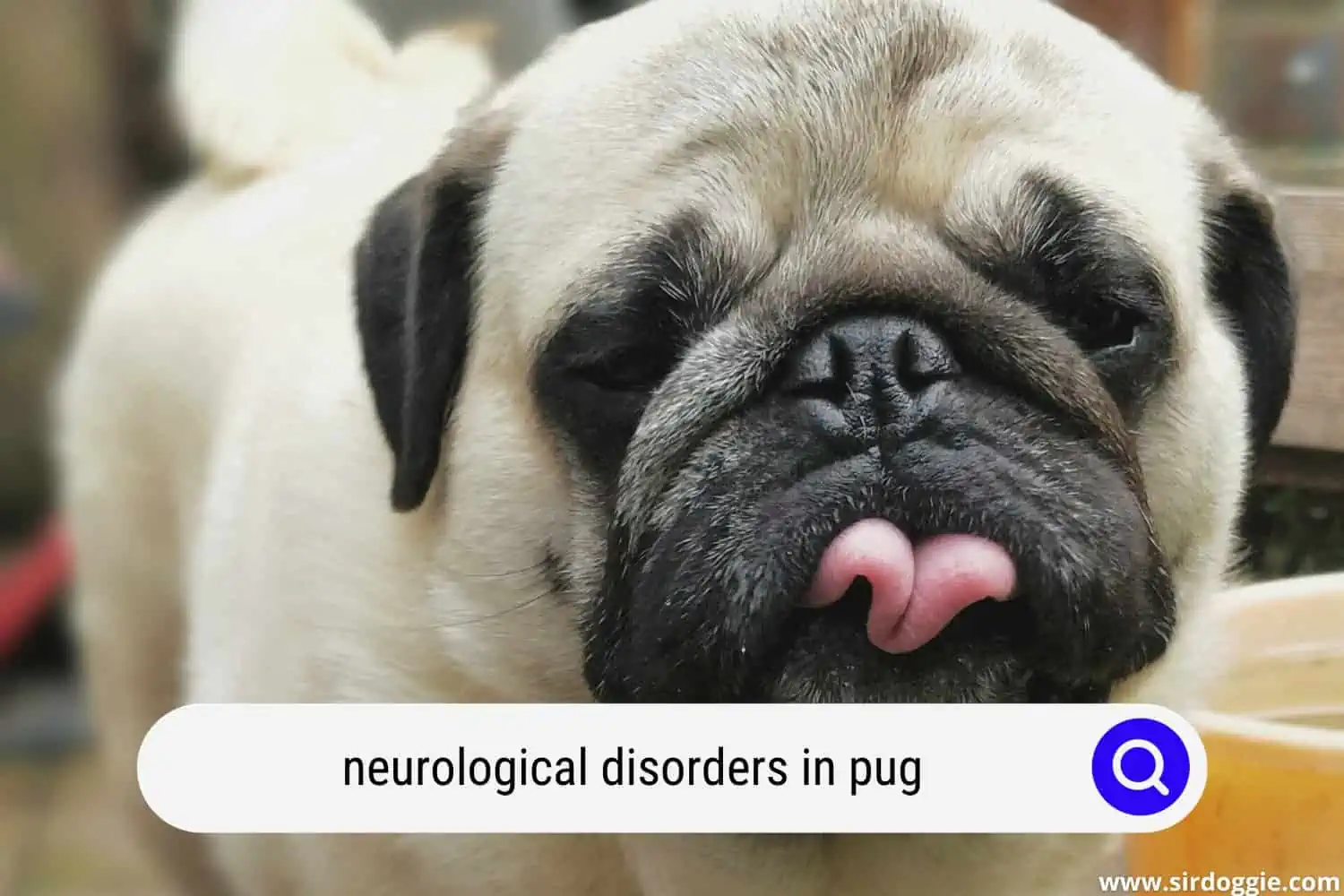Pug Neurological Disorders: 3 Main Conditions That Make One Suffering Pug
Pugs are no doubt one of the most popular dog breeds out there. They are very family-friendly, dorky, clownish, and very cuddly as well. Pancake-faced came from Asia to Europe and later the US, quickly becoming a hit with numerous dog lovers.

Pugs might be the ideal pooch choice for those lonely retirees or people with disabilities who can’t move around much. An added bonus-they don’t need much roaming space! Unfortunately, not everything is easy-breezy with wrinkle-faced canines: they are prone to many health issues.
Especially if we mention numerous Pug’s neurological disorders with some leading to complete paralysis and/or lethal outcome. Therefore, any Pug owner must recognize the alarming signs and take immediate action upon noticing any of the symptoms we are about to mention. Let’s cover the main wellness troubles that the breed is inheriting from generation to generation.
Related Reading: Pug Myelopathy: When To Euthanize?
Pug’s Health Issues
Breathing Issues
The most common occurrence among all flat-faced creatures. A Pug is one of the brachycephalic breeds and is prone to abnormal breathing patterns because of that. Since their snouts are so tiny, they obstruct normal O2 flow and cause very pronounced sounds Pugs are known for.
For example, snoring loudly or snuffling as they walk. This is not a good health indicator and a pet parent should closely monitor any alarming signs.
If your Pug friend is a client at daycares or likes to socialize frequently in dog parks, you have to make sure its vaccines are up to date. The reason is that in facilities welcoming many dogs at the same time, viruses like Pneumonia, Kennel Cough, or Distemper transfer a lot quicker. Notice that your pal is making choking, gagging, or coughing sounds?
This could indicate one of the conditions we’ve just mentioned and you would want to check it out with a professional.
Another very common reason for troubled breathing is obesity. Any Pug parent knows that his/her fluffy pal loves food! However, this love is slowly killing it by adding many unnecessary pounds to a delicate Pug’s frame.
It is imperative to monitor how much your Pug eats and change its diet if the weight gain becomes visible.
Allergies
A Pug’s skin is very sensitive and might be prone to allergies. It is a pet parent’s responsibility to check his/her pet’s skin for any irritation, bold spots, and swelling. Parasites like mites, fleas as well as ticks are the “first in line” to be the cause of major skin irritation that wouldn’t go away for months if not properly treated.
Also, Pugs tend to get food allergies just like any other canine. Be sure to introduce new food items slowly to see if any adverse reaction is going to follow.
Eye Infections
Those big eyes are unfortunately susceptible to various vision issues. Notice that your Pug scratches its peepers and whines while doing that? Are any signs of thick yellow/green discharge collecting at the eyes’ corners?
This could indicate an infection that has to be addressed without delay! Some of them are not that serious (like gingivitis), while others might mean that your pal is developing cataracts, glaucoma, or some other serious eye ailment. Monitor any weird behavior like bumping into walls, excessive rubbing, or the pooch missing its food bowl while eating. Take your flat-faced baby to the vet ASAP if you spot any of these.
Cardiovascular Problems
These are directly related to a Pug’s breathing issues. Their flat muzzles affect the way Pugs breathe. Consequently, their hearts have to work twice as hard to pump oxygen-rich blood and deliver it to the organs.
This causes the heart to wear out after a while, and a pooch’s lifespan inevitably decreases. A weakened heart leads to strokes, heart attacks, dilated cardiomyopathy, and congestive heart failure.
Joint Problems
Even though Pugs are very compact and sturdy dogs, they do tend to develop a few joint issues. This is all because their legs are short but forced to support a heavy skeleton. Therefore, it is very easy for a wrinkled bud to get an injury.
It is especially so if pooches play actively with their other canine companions or with their two-legged human siblings. Pugs should not engage in straining physical activities and avoid excessive jumping as well as running.
Pug’s Neurological Disorders
Some of Pug’s neurological disorders can hinder a pup’s normal lifestyle as they have serious consequences. The three main neurological disorders in Pugs that we can name are PDE (Pug Dog Encephalitis), Pug Ataxia, and Epilepsy. The latter can either be one of the PDE’s symptoms or a stand-alone disease that has no ties to Encephalitis. Let’s look closely at each of these conditions.
PDE – Pug Dog Encephalitis
This is a condition when a pup’s brain is affected and a poor wrinkled creature becomes very disoriented, weak, restless, or lethargic. The exact cause is, sadly, unclear. However, some scientists argue that this disorder is hereditary, being transferred from an affected parent to a puppy.
A few symptoms can include bad seizures, bumping into walls, rubbing up against objects or people, aggression, or, on the contrary, complete lethargy/loss of interest in everything.
Pug Ataxia – Pug Myelopathy
This illness is connected to a Pug’s spinal cord damage and results in either partial or complete paralysis of its back legs. Reasons for such a complex and painful condition are usually nerve degeneration in Pugs happening when the fetus is developing in a female Pug’s womb. So, it is a genetic mutation, a DNA abnormality that just happens out of the blue.
Symptoms may include licking at the legs and feet, dragging them across hard surfaces, laying down more than normal, and on some occasions, incontinence. In the case of Degenerative Myelopathy, things can get serious very quickly. Your pal may be completely paralyzed and eventually die.
Epilepsy (Seizures)
Therefore, they are either a result of a Pug Dog Encephalitis or may be connected to a Pug being poisoned, kidney failure, toxins present in a Pug’s system, or cancer. A few of the causes may be treated while others will remain chronic and need constant professional vet monitoring, including medication prescriptions for life.
Related Reading: Are Pugs Prone To Seizures?

Curl-Up
Pugs are very complex creatures when it comes to their health. Some conditions are preventable and treatable. While others, unfortunately, are not. Pug’s neurological disorders would be in the latter category. They are most likely genetically related, driven by cell mutations and abnormalities that are, sadly, very common for Pugs. In case you notice any of the alarming symptoms we mentioned above, visit your vet immediately! Even if a condition cannot be cured, managing it on a day-to-day basis will be a lot easier.

Family Dog Expert Author
Hi there! I’m Stuart, a devoted dog lover and family dog expert with over a decade of experience working with our furry companions. My passion for dogs drives me to share my knowledge and expertise, helping families build strong, loving bonds with their four-legged friends. When I’m not writing for SirDoggie, you’ll find me hiking, playing with my beautiful dog, or studying music.